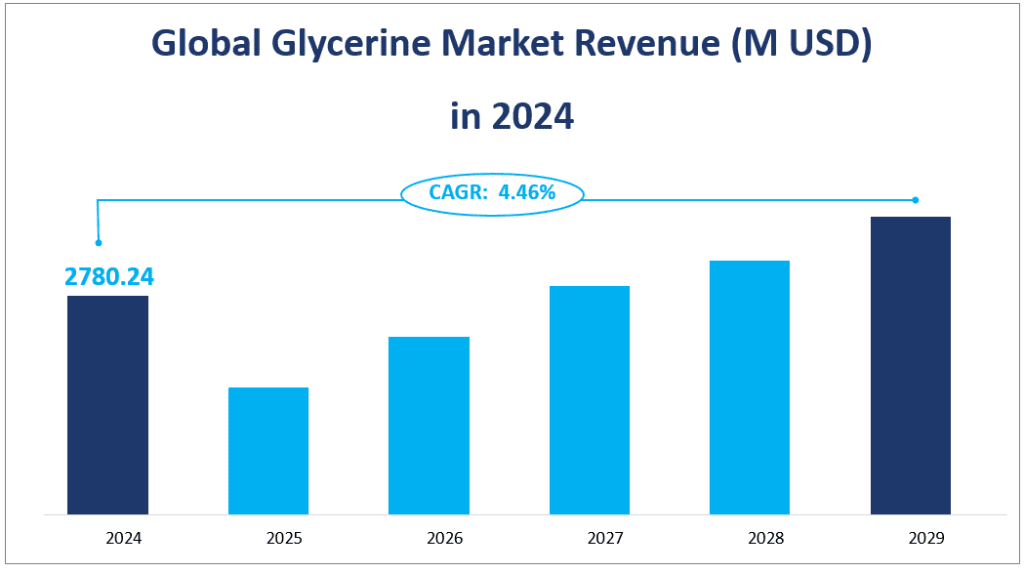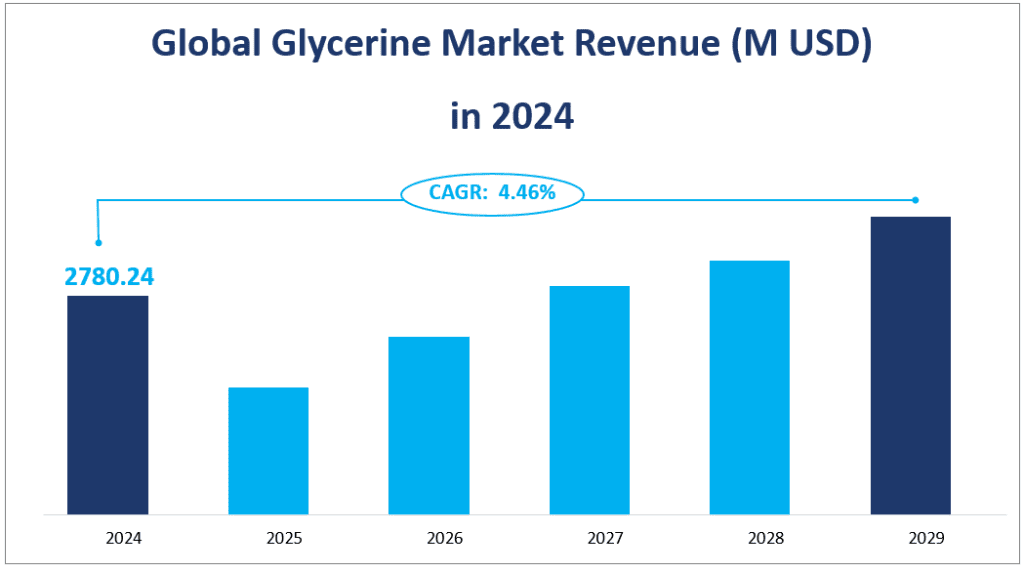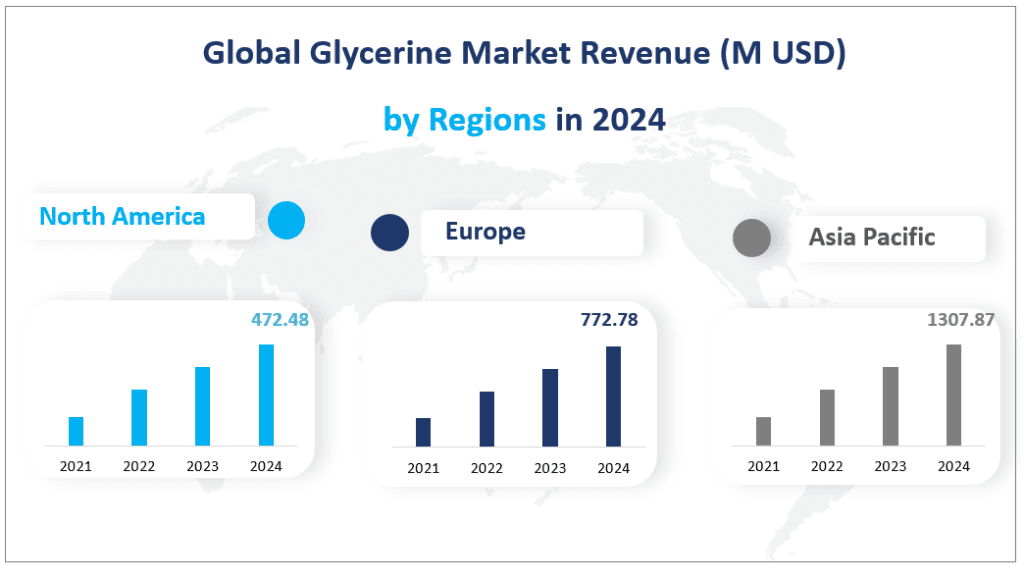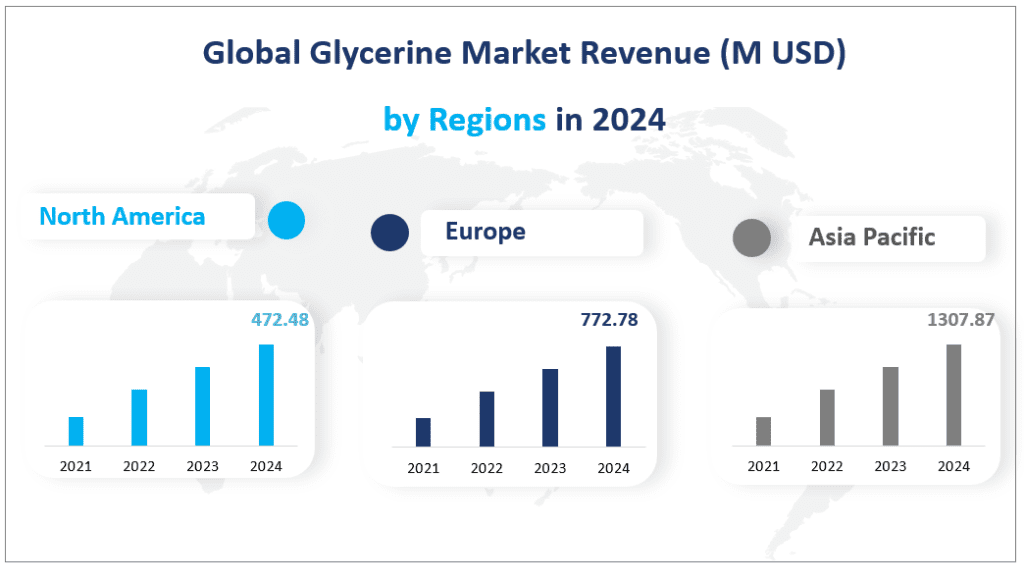1. Global Glycerine Market Overview
The global glycerine market is a significant segment within the broader chemical industry, with applications in multiple sectors, such as cosmetics, pharmaceuticals, food, and industrial chemicals. In 2024, the global glycerine market revenue is projected to reach $2,780.24 million with a CAGR of 4.46% from 2024 to 2029.
Glycerine, also known as glycerol or glycerin, is a naturally occurring, colorless, odorless, and viscous liquid. It is widely recognized for its hygroscopic properties, meaning it can absorb moisture from the air. This characteristic makes glycerine an essential ingredient in numerous products, including cosmetics and personal care items, where it acts as a humectant to retain skin moisture. In the food industry, glycerine serves as a sweetener and preservative, while in pharmaceuticals, it is used for its antimicrobial and antiviral properties, often as a component in wound care products.
Global Glycerine Market Revenue (M USD) in 2024


2. Driving Factors of Glycerine Market
Increasing Demand from Downstream Industries
The primary driver of the glycerine market is the growing demand from end-use industries. In the pharmaceutical sector, glycerine’s antimicrobial properties make it a key ingredient in wound care products and various medications. The cosmetics and personal care industry relies heavily on glycerine for its moisturizing effects, contributing significantly to the market’s expansion. Additionally, the food industry’s need for natural sweeteners and preservatives further fuels glycerine market demand.
Rising Environmental Awareness
With an increasing global focus on sustainability and eco-friendly practices, glycerine’s status as a by-product of biodiesel production positions it as a green alternative to synthetic chemicals. This aligns with the trend of companies seeking to reduce their carbon footprint and adopt more sustainable raw materials.
Technological Advancements
Innovations in glycerine market production processes have led to increased efficiency and reduced costs. Advanced refining techniques allow for higher purity glycerine, expanding its applications and making it more accessible to various industries. These technological advancements also contribute to the glycerine market’s growth by enhancing supply and quality.
Health and Wellness Trends
The growing consumer preference for natural and organic products has led to increased demand for glycerine market in health and wellness applications. Its use in dietary supplements, nutraceuticals, and natural cosmetics aligns with the trend of consumers seeking healthier and more sustainable products.
3. Limiting Factors of Glycerine Market
Regulatory Constraints
The glycerine market faces stringent regulatory requirements, especially in industries like pharmaceuticals and food. These regulations ensure product safety and quality but can also create barriers to entry for new players and increase compliance costs for existing manufacturers.
Price Volatility
Fluctuations in raw material prices, particularly those related to biodiesel production, can impact glycerine prices. This volatility can affect profit margins and market stability, making it challenging for manufacturers to maintain consistent pricing and supply.
Competition from Synthetic Alternatives
While glycerine has numerous advantages, synthetic alternatives continue to compete in certain applications. The availability of cheaper synthetic glycerine or other substitute chemicals can limit market growth in some sectors.
Supply Chain Challenges
The glycerine market relies on a complex supply chain involving raw material suppliers, manufacturers, and downstream buyers. Disruptions in any part of this chain, such as natural disasters, geopolitical issues, or logistical problems, can impact market performance.
4. Analysis of Glycerine Market Segment
Market Revenue by Product Type
Refined Glycerine: In 2024, the revenue generated by refined glycerine is projected to reach $2,670.53 million. Refined glycerine, with a purity level between 92% and 99.8%, is widely used in high-end applications such as cosmetics, pharmaceuticals, and the food industry. Its high purity and versatility make it a preferred choice for industries requiring stringent quality standards. As a result, refined glycerine holds the largest market share, accounting for approximately 96.05% of the total glycerine market revenue in 2024.
Crude Glycerine: The revenue from crude glycerine is estimated at $109.71 million in 2024. Crude glycerine, which contains impurities such as water, ash, and methanol, is primarily used in industrial applications like oleo chemistry, biogas production, and animal feed. Despite its lower purity, crude glycerine remains an essential product for industries where high purity is not a critical requirement. It holds a market share of 3.95% in 2024.
Market Revenue by Application
Cosmetics and Personal Care: This application segment is projected to generate a revenue of $971.97 million in 2024. Glycerine is a critical ingredient in cosmetics and personal care products due to its moisturizing and humectant properties. It is used in products such as creams, lotions, and hair care items to retain moisture and enhance product performance. This application holds the largest market share, accounting for 34.96% of the total glycerine market revenue in 2024.
Food: The food industry is another significant consumer of glycerine, with a projected revenue of $317.36 million in 2024. Glycerine is used as a sweetener, humectant, and preservative in various food products, including baked goods, low-fat foods, and beverages. This application holds a market share of 11.41% in 2024.
Pharmaceuticals: The pharmaceutical sector is expected to generate a revenue of $340.06 million from glycerine in 2024. Glycerine’s antimicrobial and antiviral properties make it an essential component in wound care products, ointments, and other pharmaceutical formulations. This application holds a market share of 12.23% in 2024.
Chemicals: The chemicals industry, which uses glycerine in the production of resins, antifreeze, and other industrial compounds, is projected to generate a revenue of $772.82 million in 2024. This application holds a market share of 27.80% in 2024.
Tobacco: The tobacco industry uses glycerine to improve moisture retention in tobacco products. In 2024, this application is expected to generate a revenue of $90.96 million, holding a market share of 3.27%.
Others: Other applications, including industrial uses and emerging markets, are projected to generate a revenue of $287.06 million in 2024, holding a market share of 10.33%.
The pharmaceutical application segment is expected to exhibit the fastest growth rate. This growth is driven by the increasing demand for glycerine in wound care products and pharmaceutical formulations, particularly in emerging markets where healthcare infrastructure is expanding.
Market Revenue and Share by Segment
| Revenue (M USD) in 2024 | Market Share in 2024 | ||
| By Type | Crude | 2670.53 | 96.05% |
| Refined | 109.71 | 3.95% | |
| By Application | Cosmetics and Personal Care | 971.97 | 34.96% |
| Food | 317.36 | 11.41% | |
| Tobacco | 90.96 | 3.27% | |
| Chemicals | 772.82 | 27.80% | |
| Pharmaceutical | 340.06 | 12.23% |
5. Regional Glycerine Market
Asia-Pacific: The Asia-Pacific region is projected to generate a revenue of $1,307.87 million in 2024. This region holds the largest glycerine market share, accounting for 47.02% of the global glycerine market revenue. The dominance of the Asia-Pacific region is driven by the rapid industrialization and economic growth in countries such as China, India, and Southeast Asia. These countries have a high demand for glycerine market in various applications, including cosmetics, pharmaceuticals, and industrial chemicals.
Europe: Europe is expected to generate a revenue of $772.78 million in 2024. The region’s glycerine market is characterized by a mature industrial base and stringent regulatory standards. The demand for glycerine in Europe is primarily driven by the cosmetics, pharmaceutical, and food industries. The region’s focus on high-quality and sustainable products aligns well with the growing global trend towards eco-friendly and natural ingredients.
North America: North America is projected to generate a revenue of $472.48 million in 2024. The region’s glycerine market is driven by the strong demand from the pharmaceutical and cosmetics industries. The United States, in particular, is a significant consumer of glycerine due to its advanced healthcare and personal care sectors. The region’s market growth is also supported by technological advancements and a focus on high-quality products.
Latin America: Latin America is expected to generate a revenue of $129.59 million in 202. The region’s glycerine market is characterized by growing demand from emerging economies such as Brazil and Mexico. The demand for glycerine in Latin America is primarily driven by the food, cosmetics, and industrial sectors. The region’s market growth is supported by increasing industrialization and expanding downstream applications.
Middle East and Africa: The Middle East and Africa region is projected to generate a revenue of $97.53 million in 2024. The region’s glycerine market is driven by the growing demand from the cosmetics and pharmaceutical industries in countries such as Turkey, Saudi Arabia, and the UAE. The region’s market growth is also supported by increasing urbanization and the development of downstream industries.
Global Glycerine Market Revenue (M USD) by Regions in 2024


6. Analysis of Top 3 Companies in the Glycerine Market
Wilmar International, founded in 1991 and headquartered in Singapore, is one of the world’s leading agribusiness groups. The company operates across the entire value chain of agricultural commodities, from cultivation and milling to processing and distribution. Wilmar’s integrated business model includes the production of edible oils, oleochemicals, and biodiesel, making it a significant player in the global glycerine market.
Wilmar International offers a range of glycerine products, including refined glycerine that meets USP, EP, and BP standards. These products are used in various applications such as cosmetics, pharmaceuticals, food, and industrial processes. Wilmar’s glycerine is known for its high purity and versatility, making it suitable for both high-end and industrial applications.
In 2022, Wilmar International’s glycerine marekt sales revenue was $370.62 million.
IOI Oleochemicals, a division of IOI Group, is one of the largest oleochemical producers globally. Established in 1970, the company operates in Malaysia, Germany, and Brazil, with a strong focus on sustainability and innovation. IOI Oleochemicals specializes in the production of fatty acids, glycerine, soap noodles, and specialty oleochemical derivatives, catering to a wide range of industries.
IOI Oleochemicals offers high-quality glycerine products under the brand name Palmac®, which are used in cosmetics, pharmaceuticals, food, and industrial applications. The company’s glycerine products are known for their consistency in quality and reliability of supply, making them a preferred choice for many downstream industries.
In 2022, IOI Oleochemicals’ glycerine market sales revenue was $250.50 million.
KLK OLEO, a subsidiary of Kuala Lumpur Kepong Berhad, is a leading global producer of oleochemicals. Established in 1906, the company operates in Malaysia and China, with a strong focus on sustainable and high-quality products. KLK OLEO’s integrated oleochemical complexes produce a wide range of products, including glycerine, fatty acids, and specialty derivatives, serving customers worldwide.
KLK OLEO offers refined glycerine products that meet international standards such as USP, EP, and BP. These products are used in various applications, including pharmaceuticals, cosmetics, food, and industrial processes. KLK OLEO’s glycerine is known for its high purity and versatility, making it suitable for both high-end and industrial applications.
In 2022, KLK OLEO’s glycerine market sales revenue was $195.58 million.
Major Players
| Company Name | Plant Locations | Market Distribution |
| Wilmar International | Mainly in Southeast Asia | Worldwide |
| IOI Oleochemicals | Mainly in Malaysia, Germany, Brazil | Worldwide |
| KLK OLEO | Mainly in Malaysia, China | Worldwide |
| P&G Chemicals | Mainly in USA, Malaysia | Mainly in Americas, EMEA, Asia Pacific |
| Musim MAS | Mainly in Indonesia | Mainly in Asia Pacific, Europe, USA |
| Emery Oleochemicals | Mainly in USA | Mainly in North America, Europe, Asia Pacific |
| Louis Dreyfus Company | Mainly in the US and Germany | Mainly in EMEA, America, Asia |
| Oleon | Mainly in Belgium, France, Germany | Mainly in Europe, Asia Pacific, North America |
| Vance Bioenergy | Mainly in Malaysia | Mainly in Asia, Europe, USA |
| Cargill | Mainly in USA | Worldwide |
| Shuangma Chemical | Mainly in China | Mainly in Asia Pacific |
| Qingyuan Futai | Mainly in China | Mainly in Asia |
| Cambridge Olein | Mainly in China | Mainly in Asia |
| Godrej Industries | Mainly in India | Mainly in Asia Pacific |
1 Glycerin Introduction and Market Overview
1.1 Objectives of the Study
1.2 Overview of Glycerin
1.3 Glycerin Market Scope and Market Size Estimation
1.3.1 Market Concentration Ratio and Market Maturity Analysis
1.3.2 Global Glycerin Value and Growth Rate from 2017-2027
1.4 Market Segmentation
1.4.1 Types of Glycerin
1.4.2 Applications of Glycerin
1.4.3 Research Regions
1.5 Market Dynamics
1.5.1 Drivers
1.5.2 Limitations
1.5.3 Opportunities
1.6 Industry News and Policies by Regions
1.6.1 Industry News
1.6.2 Industry Policies
1.7 Glycerin Industry Development Trends under COVID-19 Outbreak
1.7.1 Global COVID-19 Status Overview
1.7.2 Influence of COVID-19 Outbreak on Glycerin Industry Development
1.8 Impact of Russia and Ukraine War
2 Industry Chain Analysis
2.1 Upstream Raw Material Suppliers of Glycerin Analysis
2.2 Major Players of Glycerin
2.2.1 Major Players Manufacturing Base of Glycerin in 2021
2.2.2 Major Players Market Distribution in 2021
2.3 Glycerin Manufacturing Cost Structure Analysis
2.3.1 Production Process Analysis
2.3.2 Manufacturing Cost Structure of Glycerin
2.3.3 Raw Material Cost of Glycerin
2.3.4 Labor Cost of Glycerin
2.4 Market Channel Analysis of Glycerin
2.5 Major Downstream Buyers of Glycerin Analysis
3 Global Glycerin Market, by Type
3.1 Global Glycerin Value and Market Share by Type (2017-2022)
3.2 Global Glycerin Production and Market Share by Type (2017-2022)
3.3 Global Glycerin Value and Growth Rate by Type (2017-2022)
3.3.1 Global Glycerin Value and Growth Rate of Technical grade glycerin
3.3.2 Global Glycerin Value and Growth Rate of USP grade glycerin
3.4 Global Glycerin Price Analysis by Type (2017-2022)
4 Glycerin Market, by Application
4.1 Downstream Market Overview
4.2 Global Glycerin Consumption and Market Share by Application (2017-2022)
4.3 Global Glycerin Consumption and Growth Rate by Application (2017-2022)
4.3.1 Global Glycerin Consumption and Growth Rate of Food and Beverages (2017-2022)
4.3.2 Global Glycerin Consumption and Growth Rate of Pharmaceutical (2017-2022)
5 Global Glycerin Production, Value ($) by Region (2017-2022)
5.1 Global Glycerin Value and Market Share by Region (2017-2022)
5.2 Global Glycerin Production and Market Share by Region (2017-2022)
5.3 Global Glycerin Production, Value, Price and Gross Margin (2017-2022)
5.4 North America Glycerin Production, Value, Price and Gross Margin (2017-2022)
5.5 Europe Glycerin Production, Value, Price and Gross Margin (2017-2022)
5.6 China Glycerin Production, Value, Price and Gross Margin (2017-2022)
5.7 Japan Glycerin Production, Value, Price and Gross Margin (2017-2022)
5.8 Middle East and Africa Glycerin Production, Value, Price and Gross Margin (2017-2022)
5.9 India Glycerin Production, Value, Price and Gross Margin (2017-2022)
5.10 South America Glycerin Production, Value, Price and Gross Margin (2017-2022)
6 Global Glycerin Production, Consumption, Export, Import by Regions (2017-2022)
6.1 Global Glycerin Consumption by Regions (2017-2022)
6.2 North America Glycerin Production, Consumption, Export, Import (2017-2022)
6.3 Europe Glycerin Production, Consumption, Export, Import (2017-2022)
6.4 China Glycerin Production, Consumption, Export, Import (2017-2022)
6.5 Japan Glycerin Production, Consumption, Export, Import (2017-2022)
6.6 Middle East and Africa Glycerin Production, Consumption, Export, Import (2017-2022)
6.7 India Glycerin Production, Consumption, Export, Import (2017-2022)
6.8 South America Glycerin Production, Consumption, Export, Import (2017-2022)
7 Global Glycerin Market Status and SWOT Analysis by Regions
7.1 North America Glycerin Market Status and SWOT Analysis
7.1.1 North America Glycerin Market Under COVID-19
7.2 Europe Glycerin Market Status and SWOT Analysis
7.2.1 Europe Glycerin Market Under COVID-19
7.3 China Glycerin Market Status and SWOT Analysis
7.3.1 China Glycerin Market Under COVID-19
7.4 Japan Glycerin Market Status and SWOT Analysis
7.4.1 Japan Glycerin Market Under COVID-19
7.5 Middle East and Africa Glycerin Market Status and SWOT Analysis
7.5.1 Middle East and Africa Glycerin Market Under COVID-19
7.6 India Glycerin Market Status and SWOT Analysis
7.6.1 India Glycerin Market Under COVID-19
7.7 South America Glycerin Market Status and SWOT Analysis
7.7.1 South America Glycerin Market Under COVID-19
8 Competitive Landscape
8.1 Competitive Profile
8.2 Wilmar International
8.2.1 Company Profiles
8.2.2 Glycerin Product Introduction
8.2.3 Wilmar International Production, Value, Price, Gross Margin 2017-2022
8.3 IOI Corporation Berhad
8.3.1 Company Profiles
8.3.2 Glycerin Product Introduction
8.3.3 IOI Corporation Berhad Production, Value, Price, Gross Margin 2017-2022
8.4 KLK OLEO
8.4.1 Company Profiles
8.4.2 Glycerin Product Introduction
8.4.3 KLK OLEO Production, Value, Price, Gross Margin 2017-2022
8.5 Procter & Gamble
8.5.1 Company Profiles
8.5.2 Glycerin Product Introduction
8.5.3 Procter & Gamble Production, Value, Price, Gross Margin 2017-2022
8.6 Oleon NV
8.6.1 Company Profiles
8.6.2 Glycerin Product Introduction
8.6.3 Oleon NV Production, Value, Price, Gross Margin 2017-2022
8.7 Cargill
8.7.1 Company Profiles
8.7.2 Glycerin Product Introduction
8.7.3 Cargill Production, Value, Price, Gross Margin 2017-2022
8.8 Emery Oleochemicals
8.8.1 Company Profiles
8.8.2 Glycerin Product Introduction
8.8.3 Emery Oleochemicals Production, Value, Price, Gross Margin 2017-2022
8.9 Croda International
8.9.1 Company Profiles
8.9.2 Glycerin Product Introduction
8.9.3 Croda International Production, Value, Price, Gross Margin 2017-2022
8.10 Air Liquide
8.10.1 Company Profiles
8.10.2 Glycerin Product Introduction
8.10.3 Air Liquide Production, Value, Price, Gross Margin 2017-2022
8.11 Louis Dreyfus Company
8.11.1 Company Profiles
8.11.2 Glycerin Product Introduction
8.11.3 Louis Dreyfus Company Production, Value, Price, Gross Margin 2017-2022
9 Global Glycerin Market Analysis and Forecast by Type and Application
9.1 Global Glycerin Market Value & Volume Forecast, by Type (2022-2027)
9.1.1 Technical grade glycerin Market Value and Volume Forecast (2022-2027)
9.1.2 USP grade glycerin Market Value and Volume Forecast (2022-2027)
9.2 Global Glycerin Market Value & Volume Forecast, by Application (2022-2027)
9.2.1 Food and Beverages Market Value and Volume Forecast (2022-2027)
9.2.2 Pharmaceutical Market Value and Volume Forecast (2022-2027)
10 Glycerin Market Analysis and Forecast by Region
10.1 North America Market Value and Consumption Forecast (2022-2027)
10.2 Europe Market Value and Consumption Forecast (2022-2027)
10.3 China Market Value and Consumption Forecast (2022-2027)
10.4 Japan Market Value and Consumption Forecast (2022-2027)
10.5 Middle East and Africa Market Value and Consumption Forecast (2022-2027)
10.6 India Market Value and Consumption Forecast (2022-2027)
10.7 South America Market Value and Consumption Forecast (2022-2027)
10.8 Glycerin Market Forecast Under COVID-19
11 New Project Feasibility Analysis
11.1 Industry Barriers and New Entrants SWOT Analysis
11.2 Analysis and Suggestions on New Project Investment
12 Research Finding and Conclusion
13 Appendix
13.1 Methodology
13.2 Research Data Source
